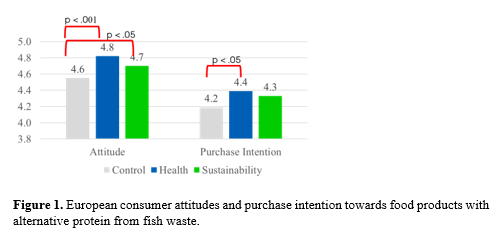DO CONSUMERS WANT TO EAT ALTERNATIVE PROTEINS FROM FISH WASTE? RAISING EUROPEAN CONSUMER AWARENESS THROUGH COMMUNICATION
Acknowledgements
This study has received funding from EIT Food (https://www.eitfood.eu/) through the project “EcoD: Bringing new life to cod waste by turning it into food ” (Grant number ID: 20432 , EIT Food Business Plan 2020).
Introduction
T he increased processing in fish production results in massive production of waste (20–80% of landed weight is wasted depending on the processing type)
. There are many efforts of using this waste in feed, food packaging, biofuels
and to recover more for use as human food, where this by-products can be transformed into high quality fish protein, which can be added to a wide range of food products and thereby contribute to both health and the circular economy
. Thus, valorization and upcycling of by-products, such as those coming from fish waste, can have many potential applications through product development in the fish and food industry
.
The next important step for European seafood industry is raising consumer awareness on the above issues, as well as on environmental and health potential of alternative proteins coming from fish waste. This is vital for managers and p olicy makers in order to be able to design and employ appropriate strategies around new alternative proteins coming from fish waste. Consequently , in this study, and in a cross-cultural context, it is examined h ow European consumers respond to new products with alternative proteins coming from fish waste while accounting for the different communication messages related to the health and environmental benefits.
Materials and methods
An online cross-cultural study has been conducted in three European countries, namely Denmark, France and Germany with a total sample of 2700 participants . Three experimental conditions have been considered: control and two message framing conditions (health vs. sustainability) to assess whether the consumers acceptance of alternative proteins coming from fish waste would be improved due to the health or sustainability messages or just plain preference (control condition) when focusing on possible food products. After reading and signing the informed consent, participants were randomly assigned to one of three above mentioned experimental conditions, where they answered questions regarding their attitudes towards fish protein , health and environmental consciousness, purchase behavior, and socio demographics, among others.
Results
The results show that the European consumers are open towards having alternative proteins from fish waste. They associate these new proteins with health benefits, and believe that they could add to a more diverse diet and more choice. Some differences have been found across European countries where French and German consumers seem to be more positive towards and more likely to buy food products containing fish protein than the Danish consumers. On the contrary, Danish consumers were found to be more reluctant towards these proteins and products containing them . In terms of communication, it seems that when health benefits are emphasized, consumers had more positive attitudes and more likely to buy food products with new fish protein, see Figure 1.
Conclusions
The valorization and upcycling of fish waste adds-value to the fish production and provides more choice for the consumers. This is significant as the European demand for fish products significantly surpasses the supply that fish sector can provide . In this context, fish industry and policy makers need to become more efficient in valorizing the fish waste and raising consumer awareness which is especially important now in the light of the green deal and farm-to-fork call for a fair, healthy and environmentally-friendly food system.
References
Alfio, V. G., Manzo, C., & Micillo, R. (2021). From Fish Waste to Value: An Overview of the Sustainable Recovery of Omega-3 for Food Supplements. Molecules, 26(4), 1002.
Arvanitoyannis, I. S., & Kassaveti, A. (2008). Fish industry waste: treatments, environmental impacts, current and potential uses. International journal of food science & technology, 43(4), 726-745.
Ghaly, A., Ramakrishnan, V., Brooks, M., Budge, S., & Dave, D. (2013). Fish processing wastes as a potential source of proteins. Amino acids and oils: a critical review. J Microb Biochem Technol, 5(4), 107-129.
Jayasinghe, P., & Hawboldt, K. (2012). A review of bio-oils from waste biomass: Focus on fish processing waste. Renewable and sustainable energy reviews, 16(1), 798-821.
Nawaz, A., Li, E., Irshad, S., Hammad, H., Liu, J., Shahbaz, H. M., . . . Regenstein, J. M. (2020). Improved effect of autoclave processing on size reduction, chemical structure, nutritional, mechanical and in vitro digestibility properties of fish bone powder. Advanced Powder Technology, 31(6), 2513-2520.
